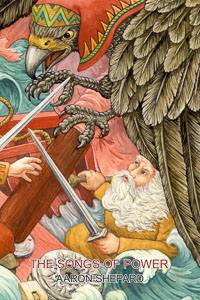Here is the author note found in my mini-novel, as well as in my picture book, The Maiden of Northland.—Aaron
This story is based on the Kalevala (pronounced “KAH‑lev-AH‑la”), the great national epic of Finland. The Kalevala was compiled in the 1800s by Elias Lönnrot (“EL‑ee‑us LERN‑root”)—physician, literary scholar, linguist—who was inspired by the nationalist philosophy of his times to uncover a literary heritage for the Finnish people. His medical circuits and research trips took him to outlying villages on both sides of Finland’s border with Russia, where he recorded Finnish folk poems, called runes, performed by local singers.
These poems, along with many collected by other researchers, were combined by Lönnrot into the most important book ever to appear in Finland. His epic became a pillar of Finnish nationalism, helping to generate a new pride in Finnish national identity, a revival of the Finnish language, and an independence movement that eventually won for Finland its freedom from Russian rule.
Today, every Finnish boy and girl knows stories from the Kalevala and studies the epic in school. Children, streets, towns, and businesses are named after Kalevala characters, and Finnish art, music, dance, and theater frequently draw on Kalevala themes. Internationally, the Kalevala is recognized as a masterpiece of world literature.
For this retelling, I have drawn on not only the Kalevala itself but also on Lönnrot’s two preliminary versions of the epic and on variant runes collected in Lönnrot’s time and later. In place of the runes’ distinctive trochaic tetrameter I have employed free verse, but I’ve retained other characteristic elements, such as stock epithets, structural repetition, and parallelism. The maiden’s name, Aila, is my own invention.
The following notes may help in understanding particular elements of the story.
Transportation. Finland is a land mostly of forests, lakes, rivers, and marshes, and in the absence of paved roads during Kalevala times, wheeled vehicles were impractical. In the winter, when all waterways were frozen and snow covered everything, the sleigh was the only vehicle of transportation. In the summer—the time of this story—both boats and sleighs were used, with the sleighs running over bare ground.
Magic. The descriptions of magic in the Kalevala have survived from an ancient time when shamanism was an important part of Finnish tribal life. A similar belief pattern has been found in existing tribal cultures around the world and is thought to have once been common throughout Europe as well.
In the Kalevala, magic is made by chanting special runes. These runes often petitioned gods or spirits, or spoke of origins. According to the ancient beliefs, anyone could use the magic runes, but great magicians like Väinämöinen and Louhi knew more runes and more powerful ones than common people did. Another belief was that the spell created by a rune could be undone by singing the words in backward order.
Northland. Lönnrot and many others believed that the old runes looked back to an actual historic conflict between Northland and Kalevala, “the land of Kaleva.” (Kaleva—pronounced “KAH‑lev‑ah”—was a legendary forebear of the Finns.) But today it is considered much more likely that Northland was a mythologic or literary invention rather than a real place.
Sampo (pronounced “SOM‑po”). This may originally have been a shamanistic pillar—a giant good luck charm—but over the centuries, the original meaning of the term was lost. Various singers have described it as a chest, a boat, an eagle, or a mill—but almost always as something magical that bestows prosperity.
Kantele (pronounced “KON‑tel‑eh”). This is a type of psaltery often used to accompany rune singing. In its traditional form, the kantele is a five‑string instrument, small enough to sit on the player’s lap. The body is made of a single block of wood—curly birch, or sometimes alder or pine. Tradition says the strings were first made of horse or human hair, though today they are metal. A modern version of the instrument is about a yard (or a meter) long and has up to thirty‑six strings.
References for this retelling included English translations of Lönnrot’s Kalevala by W. F. Kirby (Dutton, New York, and Dent, London, 1907), Francis P. Magoun, Jr. (Harvard University, Cambridge, 1963), Eino Friberg (Otava Publishing Company, Helsinki, 1988), and Keith Bosley (Oxford University, Oxford and New York, 1989); The Old Kalevala and Certain Antecedents, by Elias Lönnrot, translated by Francis P. Magoun, Jr. (Harvard University, Cambridge, 1969); and Finnish Folk Poetry—Epic, edited and translated by Matti Kuusi, Keith Bosley, and Michael Branch (Finnish Literature Society, Helsinki, 1977).
For further reading in the Kalevala itself, I recommend Friberg’s translation, cited above. Good prose retellings for young people include The Magic Storysinger, by M. E. A. McNeil (Stemmer House, Owings Mills, Maryland, 1993), and The Sampo, by James Baldwin, illustrated by N. C. Wyeth (Scribners, New York, 1912).
